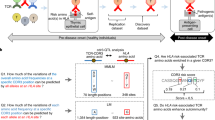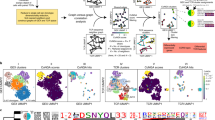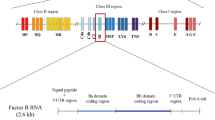Abstract
The major histocompatibility complex of the mouse, H–2, comprises 12 loci which are grouped into regions and subregions1. Present data indicate that to the ‘right’ of the H–2D there are nine loci clustered into one region, the ‘T region’. These loci are designated Qa-1, Qa-2, Qa-3, Qa-4, Qa-5, H–2T, H–31, H–32, TLa (ref. 2). The loci in the ‘T region’ may, in fact, be part of the H–2 complex. This notion is supported by the fact that gene products of the TLa, Qa-2 and Qa-3 loci share some molecular properties with H–2 products: a two-polypeptide chain complex with a common determinant of molecular weight 12,000 β2-microglobulin and a variable heavy chain of MW 45,000 (ref. 3). Recent reports suggested the possible existence of human analogues to the gene products of the murine ‘T region’. Antigenic structures, similar but not identical with HLA-A, -B and -C antigens, were recently isolated from the human lymphoblastoid T-cell line MOLT4 (refs 4,5). These reports presented evidence for the existence of a β2-microglobulin or a β2-microglobulin-like molecule, Bt, associated with a polypeptide chain of MW∼45,000. However, it remains to be determined whether these structures are equivalent to the mouse Qa-1, Qa-2 or TLa gene products. We now report the identification of human alloantisera that react with cell-surface determinants expressed on mitogen-activated T lymphocytes but not expressed on resting T cells. Antigen blocking and modulation techniques were used. The alloantigens identified (HT) are different from the classical HLA-A, -B, -C and -DR antigens but are associated with β2-microglobulin. These determinants are encoded by genes in the HLA-A region and may represent the human counterpart of the TLa region determinants of the mouse1–3.
This is a preview of subscription content, access via your institution
Access options
Subscribe to this journal
Receive 51 print issues and online access
$199.00 per year
only $3.90 per issue
Buy this article
- Purchase on Springer Link
- Instant access to full article PDF
Prices may be subject to local taxes which are calculated during checkout
Similar content being viewed by others
References
Klein, J. et al. Immunogenetics 6, 489–512 (1978).
Hammerling, G. J., Hammerling, U. & Flaherty, L. J. exp. Med. 150, 108–116 (1979).
Michaelson, J., Flaherty, L., Vitetta, E. & Poulik, M. J. exp. Med. 145, 1066–1070 (1977).
Tada, N., Tanigaki, N. & Pressman, D. J. Immun. 120, 513–519 (1978).
Ziegler, A. & Milstein, C., 279, 243–244 (1979).
Terhorst, C., Parham, P., Mann, D. & Strominger, J. L. Proc. natn. Acad. Sci U.S.A. 73, 910–914 (1976).
Ostberg, L., Rask, L., Nilsson, K. & Peterson, P. Eur. J. Immun. 5, 462–468 (1975).
Barnstable, C. J. et al. Cell 14, 9–20 (1978).
Evans, R. L. et al. J. exp. Med. 148, 1440–1445 (1978).
Fu, S. M. et al. J. exp. Med. 148, 1423–1428 (1978).
DeWolf, W. C., Schlossman, S. F. & Yunis, E. J. J. Immun. 122, 1780–1784 (1979).
Bodmer, W. F., Tripp, M. & Bodmer, J. in Histocompatibility Testing (eds Curtoni, E. S., Mattiuz, P. L. & Tosi, R. M.) 341–350 (Munksgaard, Copenhagen, 1967).
Hoffman, T. & Kunkel, H. G. in In Vitro Methods in Cell Mediated and Tumor Immunity (eds Bloom, B. R. & David, J. R.) 71–81 (Academic, New York, 1976).
Bernoco, D. et al. Tissue Antigens 8, 256–260 (1976).
Cejka, J. & Kithier, K. Archs Biochem. Biophys. 153, 854–857 (1972).
Crumpton, M. J. & Snary, D. Contemp. Topics Mol. 3, 27–56 (1974).
Robb, R., Terhorst, C. & Strominger, J. J. biol. Chem. 253, 5319–5322 (1978).
Springer, T. A. et al. Nature 268, 213–218 (1977).
Author information
Authors and Affiliations
Rights and permissions
About this article
Cite this article
Gazit, E., Terhorst, C. & Yunis, E. The human ‘T’ genetic region of the HLA linkage group is a polymorphism detected on lectin-activated lymphocytes. Nature 284, 275–277 (1980). https://doi.org/10.1038/284275a0
Received:
Accepted:
Issue Date:
DOI: https://doi.org/10.1038/284275a0
This article is cited by
-
A mutant rat major histocompatibility haplotype showing a large deletion of class I sequences
Immunogenetics (1989)
-
Alloantisera with apparent HLA-A specificity reacting only against phytohemagglutinin-activated cells
La Ricerca in Clinica e in Laboratorio (1986)
Comments
By submitting a comment you agree to abide by our Terms and Community Guidelines. If you find something abusive or that does not comply with our terms or guidelines please flag it as inappropriate.



